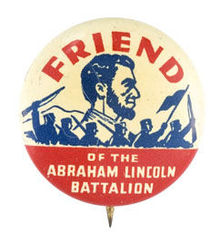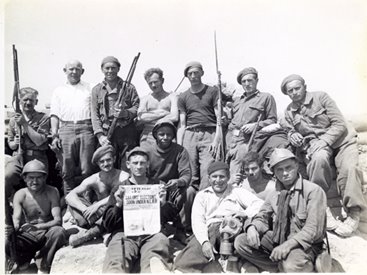Ab
Abraham Lincoln Brigade
The Abraham Lincoln Brigade refers to volunteers from the United States who served in the Spanish Civil War in the International Brigades. They fought for Spanish Republican forces against Franco and the Spanish Nationalists.

As time went on, the name Abraham Lincoln Brigade became used loosely, in the United States, as shorthand to describe any unit with an American component. Volunteers from the United States also served with the Canadian Mackenzie-Papineau Battalion, the Regiment de Tren (transport), and the John Brown Anti-Aircraft Battery. North Americans also ran a very well-organized and well-equipped field hospital (funded and staffed by the American Medical Bureau to Save Spanish Democracy).
History
Creation
Washington, D.C., Feb 12, 1938. Americans, all of whom fought and many wounded while fighting for the Republicans in Spain, met this day in Washington at the First National Conference of the Veterans of the Abraham Lincoln Brigade, left to right: Francis J. Gorman, President of the United Textile Workers of America; Lieut. Robert Raven, wounded and blinded in the Spanish War; and Commander Paul Burns of Boston Commander of the Lincoln Brigade.
The Abraham Lincoln Brigade was made up of volunteers from all walks of American life, and from all classes. Many of the people who volunteered for the Abraham Lincoln Brigade were official members of the Communist Party USA or affiliated with other socialist or anarchist organizations, such as the Uruguayan Hugo Fernández Artucio.[citation needed] Members of the Industrial Workers of the World ("Wobblies") were also represented. It is sometimes thought to be the first American military unit to be commanded by a black officer, Oliver Law.[1]
American volunteers began organizing and arriving in Spain in 1936. Centered in the town of Figueres, near the border with France, the brigade was organized in 1937 and trained by Robert Hale Merriman.  The Lincolns suffered from poor training and inept leaders, including both Merriman and Law, who were selected for command primarily for political reasons. The battalion only had one capable commander, Steve Nelson, who took command too late to turn it into a truly effective combat unit.
The Lincolns suffered from poor training and inept leaders, including both Merriman and Law, who were selected for command primarily for political reasons. The battalion only had one capable commander, Steve Nelson, who took command too late to turn it into a truly effective combat unit.
By early 1937, its numbers had swelled from an initial 96 volunteers to around 450 members. In February 1937, the European powers comprising the League of Nations Non-Intervention Committee banned foreign national volunteers.
In 1939, The Roosevelt Administration’s Attorney-General, Frank Murphy indicted 16 alleged Communists and fellow travelers for having recruited volunteers for the Abraham Lincoln Brigade supporting Spanish Republican forces against Franco and the Nationalists. This earned Murphy censure from liberals.[2]
Service
The International Brigade took part in several battles in Spain. They unsuccessfully defended the supply road between Valencia and Madrid in the Jarama Valley from February 1937 until June 1937. They were also present at the battles of Brunete, Zaragoza, Belchite, Teruel, and Ebro River.
The Brigade was a cause célčbre in some liberal and socialist circles in the United States. Some groups organized fundraising activities and supply drives to keep the brigade afloat. News of the brigade’s high casualty rate and bravery in battle made them heroic figures to Americans opposing the rise of fascism. Paul Robeson was one high profile supporter, even going so far as to visit the Lincolns in the field in Spain and appearing in publicity photographs (the XV International Brigade had its own photographic unit).
The war dragged on and the Nationalist forces, supported by Nazi Germany under Hitler and Fascist Italy under Mussolini, gained victory after victory over the Republic, which was increasingly dominated by the Spanish Communist Party (PCE). The International Brigade was withdrawn from battle by the Spanish prime minister Juan Negrín, after the Non-Intervention Committee ordered the withdrawal of the International Brigades in the spring of 1938.[3] Most of the surviving Lincolns were repatriated promptly afterwards.
Of the more than 3,000 who fought in the battalion during the conflict, over one-third were killed.[4]
Aftermath
During and after the Spanish Civil War, members of the brigade were generally viewed as supporters of the Soviet Union. However, the Hitler-Stalin pact caused a division among the Lincoln Brigade veterans. Some of them, adopting the official Communist line that regarded the war in Europe as "an imperialist war", joined with the American Peace Mobilization in protesting U.S. support for Britain against Nazi Germany.[5] Others, however, persisted with the anti-Fascist line which they had followed to Spain. In particular, former Lincoln Brigade commander Milton Wolff volunteered in 1940 for the British Special Operations Executive, and arranged the provision of arms for the European resistance organizations.
During and following World War II, particularly at the height of the Second Red Scare, the U.S. government considered former members of the brigade to be security risks. In fact, FBI Director J. Edgar Hoover persuaded President Roosevelt to ensure that former ALB members fighting in U.S. Forces in World War II not be considered for commissioning as officers, or to have any type of positive distinction conferred upon them.
Etymology
The name Brigade is a misnomer. In the Spanish Civil War, a brigade consisted of four to six battalions.[6] American volunteers mostly joined the two battalions (the Lincoln Battalion and the Washington Battalion) within XV International Brigade. The XV International Brigade was made up of six battalions of volunteers from nations around the globe, topped up with Spanish conscripts.[7] Irish volunteers formed the Connolly Column of the battalion under the command of Frank Ryan. The column joined the American rather than the British battalion on nationalist grounds.
Anthem: "Valley of Jarama"
Members of the XV International Brigade adapted a song by Alex McDade to reflect the losses at the Battle of Jarama. Sung to the tune of the traditional country song Red River Valley, it became their anthem. Members
Commanding officers
Robert Hale Merriman
Oliver Law
Martin Hourihan
Steve Nelson[8]
Hans Amlie
Milton Wolff[9]
Other notable members American veterans.
Herman Bottcher - Earned two Distinguished Service Crosses in World War II.[10]
Edward A. Carter, Jr. - Earned the Medal of Honor in World War II.
Carmelo Delgado Delgado - Puerto Rican nationalist, among the first U.S. citizens to die in the war.
Leo Eloesser - Noted US thoracic surgeon.
Moe Fishman - co-founder and Executive Secretary/Treasurer of the Veterans of the Abraham Lincoln Brigade.
John Gates - Political Commissar of the Battalion, later editor of The Daily Worker.
Robert Klonsky - One of the defendants in the Smith Act trial of the mid-1950s.
Harry Lidz -- Heroic, eccentric uncle in Franz Lidz’s 1991 memoir Unstrung Heroes and his 2003 urban historical Ghosty Men: The Strange But True Story of the Collyer Brothers[11]
Conlon Nancarrow - Composer.
Edwin Rolfe - Poet
George Sossenko - Also fought in the Durruti Column.
Robert G. Thompson - Awarded the Distinguished Service Cross in World War II; among the 1950s Smith Act trial defendants.
Harry Wayland Randall - Chief Photographer of the Photographic Unit of the 15th International Brigade.
Supporters of the Spanish Republicans
Paul Robeson -Honorary member
Dashiell Hammett
Lillian Hellman
Gypsy Rose Lee
Dorothy Parker
Pablo Picasso
Sam Yorty
Helen Keller
Ernest Hemingway
Woody Guthrie
George Orwell
Recognition
Memorials & Awards
Monument to the Abraham Lincoln Brigade in Seattle. It reads: "11 students from the University of Washington joined that historic struggle"
Currently, there are three memorials dedicated to the veterans of the Abraham Lincoln Brigade. The first is located on the campus of the University of Washington in Seattle. The second is located in James Madison Park in Madison, Wisconsin.[12] A third memorial to the veterans of the Abraham Lincoln Brigade was dedicated on the Embarcadero in San Francisco, California on March 30, 2008. Among the speakers were San Francisco mayor Gavin Newsom and a few of the several ALB veterans still living.
In museums
In 2007, Facing Fascism: New York and the Spanish Civil War at the Museum of the City of New York examines the role that New Yorkers played in the conflict, as well as the political and social ideologies that motivated them to participate in activities ranging from rallying support, fundraising, and relief aid, to fighting — and sometimes dying — on the front lines in Spain. The stories of these New Yorkers will be told through photographs, letters, uniforms, weapons, and an array of personal and historical memorabilia.
Footnotes
1. http://www.spartacus.schoolnet.co.uk/SPlawO.htm
2. John Q. Barrett, Politicians, Attorneys General, Justices, and Parallels (2007)
3. La Pasionaria’s Farewell Message to the International Brigade fighters
4. http://www.spartacus.schoolnet.co.uk/SPlincoln.htm
5. http://www.alba-valb.org/volpdf/vol_1941_02b.pdf
6. Eby (2007), p. vii
7. Eby (2007), p. 266
8. A communist, Nelson became commander of the battalion on the first day (6 July 1937) of the Battle of Brunete, replacing Martin Hourihan who was badly wounded. Eby, p 184
9. Martin, Douglas (January 17, 2008). "Milton Wolff, 92, Dies; Anti-Franco Leader.". The New York Times. Retrieved 2008-03-25. "Milton Wolff, the last commander of the American volunteers who fought against Franco in the Spanish Civil War and the longtime commander of the Veterans of the Abraham Lincoln Brigade, died Monday in Berkeley, Calif. He was 92."
10. Guide to the Veterans of the Abraham Lincoln Brigade Records 1933-2006
11. "Paid Notice: Deaths LIDZ, HARRY H.". The New York Times. 1999-04-08. Retrieved 2010-04-23.
12. ALBA - Announcements - Madison Monument dedication
Further reading
Beevor, Antony, The Battle for Spain, 2006.
Bermack, Richard. The Front Lines of Social Change: Veterans of the Abraham Lincoln Brigade, Heyday Books, 2005.
Brandt, Joe (Ed.). Black Americans In The Spanish People’s War Against Fascism 1936-1939. New York: Veterans Abraham Lincoln Brigade, no date, ca. 1979.
Carroll, Peter N.; James D. Fernández (2007). Facing Fascism: New York and the Spanish Civil War. New York University Press.
Eby,Cecil. Between the Bullet and the Lie: American Volunteers in the Spanish Civil War, New York: Holt, Rinehart & Winston, 1969.
Eby, Cecil. Comrades and Commissars,[1] 2007.
Glazer, Peter. Radical Nostalgia: Spanish Civil War Commemoration in America. New York: University of Rochester Press, 2005.
Orwell, George, "Homage to Catalonia", 1938.
Osheroff, Abraham. "Dreams and Nightmares", 1974.
Rolfe, Edwin. The Lincoln Battalion: The Story of the Americans Who Fought in Spain in the International Brigades, New York: Random House, 1939.
Thomas, Hugh, The Spanish Civil War, 4th Rev. Ed. 2001.
Yates, James. Mississippi to Madrid: Memoir of a Black American in the Abraham Lincoln Brigade. Seattle: Open Hand Publishing, 1989.
Includes content ported from Wikipedia, 2011, Creative Commons Attribution-Share Alike 3.0.